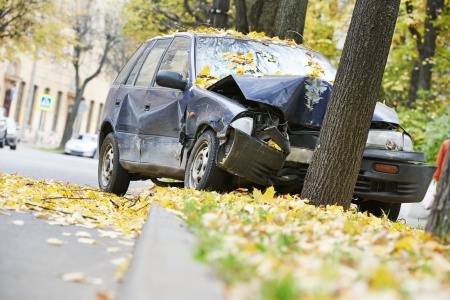

How to Avoid a Single-Car Crash
A single-car crash has occurred when only one vehicle is involved in an accident. Often, a single-vehicle accident is a runoff-road (ROR) crash. A ROR accident is when a vehicle leaves the roadway and moves onto the shoulder, median, roadside or parking lane, etc. and then crashes into an unmoving object like a tree, pole, wall or fire hydrant. In some cases, a pedestrian is hit. In a single-car accident, property damage and personal injuries are the typical outcome. Perhaps surprisingly, single-car collisions carry a higher fatality rate than head-on or side-impact collisions. About 70 percent of fatal single-vehicle crashes are ROR crashes.
Single-car crash statistics
- According to the John A. Volpe National Transportation Systems Center, one in five car accidents involve a single-vehicle veering off the roadway.
- More than 8,000 people die in single-vehicle rollover crashes in the United States each year.
How to reduce your risk of a single-car accident
Data from the Fatality Analysis Reporting System (FARS) for fatal single-vehicle ROR crashes during the period 1991 to 2007 provides insights into places and situations to avoid:
- Avoid curvy roads and isolated, rural routes
- Stay off the road during and for the first day after a winter storm
- Avoid speeding: 90 percent of ROR crashes in the study involved speeding
- Never drink and drive: Among drivers with a blood alcohol concentration of .01 grams per deciliter or higher, 86.5 percent were involved in ROR crashes in the years 1991 to 2007. By comparison, only 58.3 percent of sober drivers were involved in ROR crashes in the same time period.
- Avoid distracted driving: Almost 80 percent of all crashes and 65 percent of near-crashes were at least partly caused by some form of distracted driving within three seconds before the accident. Drivers distracted by eating, talking, fiddling with the radio or GPS or using their cell phone were 75 percent more likely to be involved in fatal, single-vehicle, ROR crashes than drivers who made driving errors such as tailgating or failing to signal a turn, according to NHTSA.
- Never drive when drowsy
How does age affect rates of single-car crashes?
Those at the beginning and end of their driving lives are at vastly increased risk of being involved in single-car accidents. Drivers between the ages of 15 and 24 have a 75 percent higher risk of being part of a ROR crash while senior drivers over the age of 65 have an increased risk of 72 percent compared to other age groups. With youth, the issue appears to be inexperience while declining peripheral vision, reflexes and depth perception increase the risk for senior drivers. Overall, older drivers are involved in more car crashes than teen drivers: according to the Insurance Institute for Highway Safety (IIHS), fatal car crash rates increase starting at age 75, and then increase sharply after age 80.
What to do if you begin drifting off a roadway
If you find yourself leaving the roadway, resist the urge to jerk your vehicle back onto the road; over-steering can cause a rollover accident. When a car begins drifting off a road to the right, the best course is to release the accelerator and slow down naturally, as the car continues straight along the shoulder. Never slam on the breaks or try to turn while breaking.
If you or a loved one is dealing with an accident or injury, you have enough on your plate. Let an experienced accident attorney fight for the full compensation that you deserve. It is not uncommon to receive a settlement from the insurance company that is five to ten times bigger with the help of a lawyer. Call the caring accident attorneys at Tario & Associates, P.S. in Bellingham, WA today for a FREE consultation! We have been representing residents of Whatcom County, Skagit County, Island County and Snohomish County since 1979. You will pay nothing up front and no attorney fees at all unless we recover damages for you!




